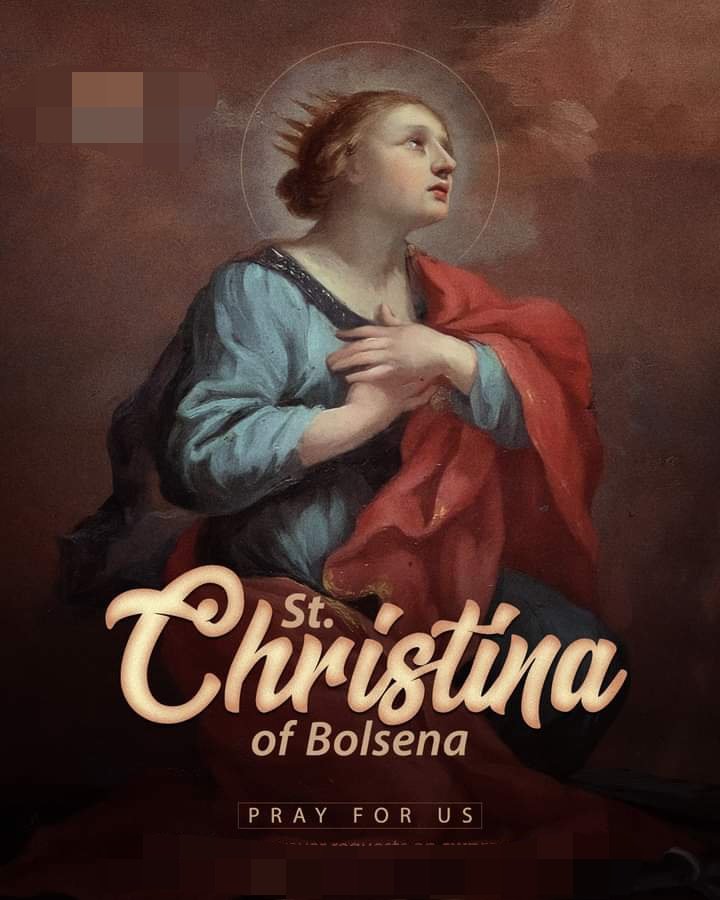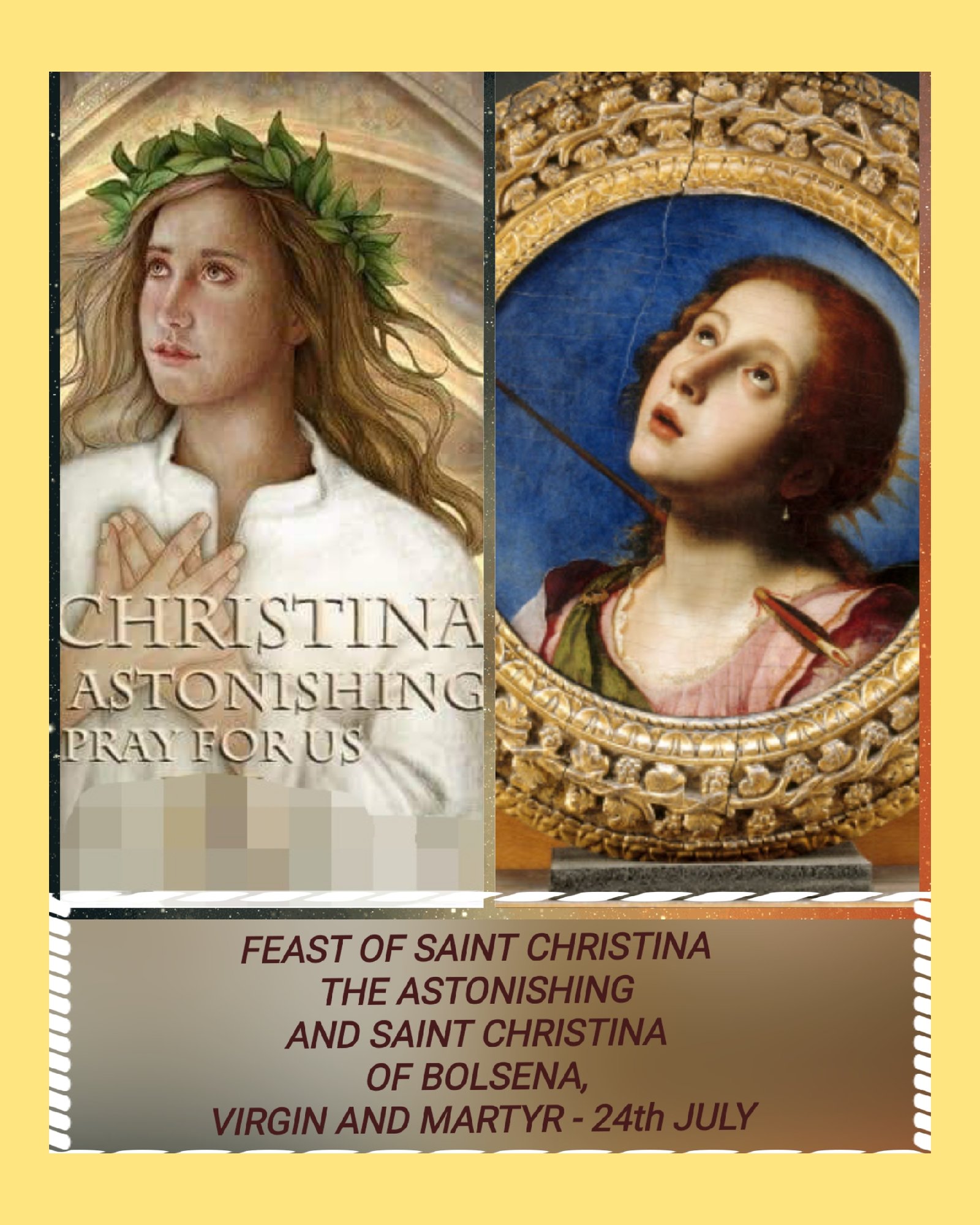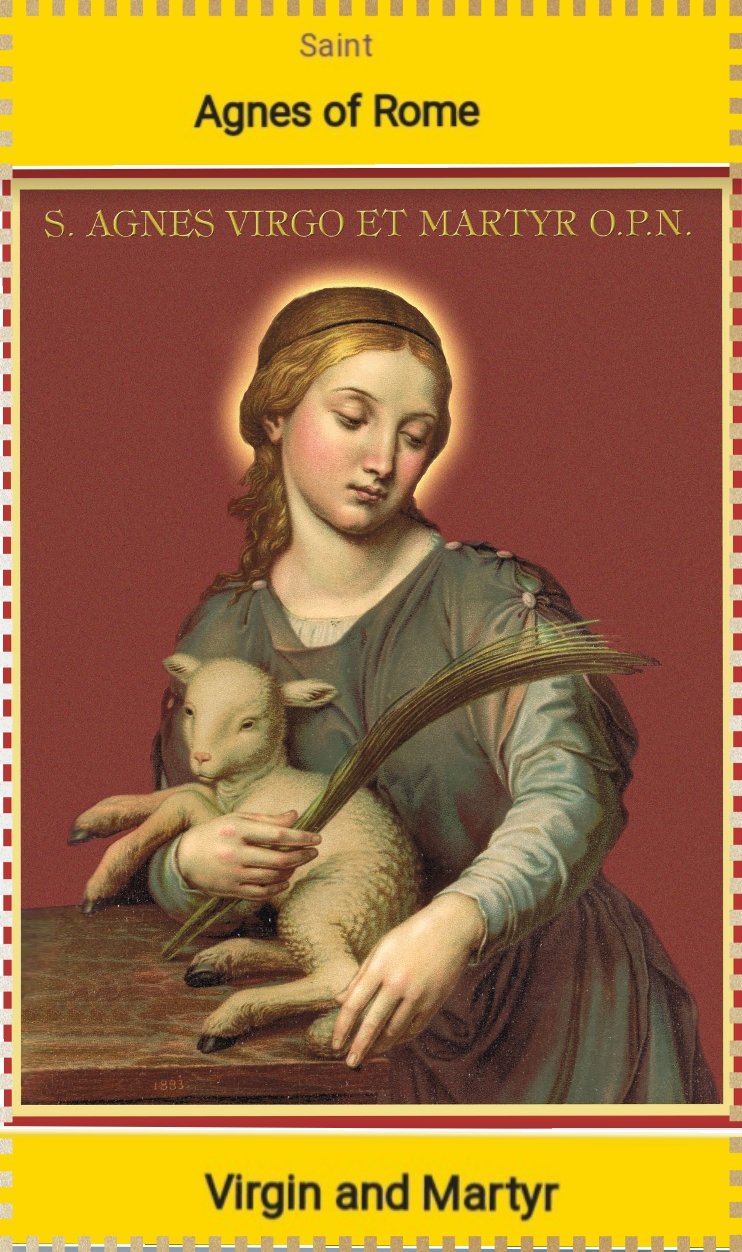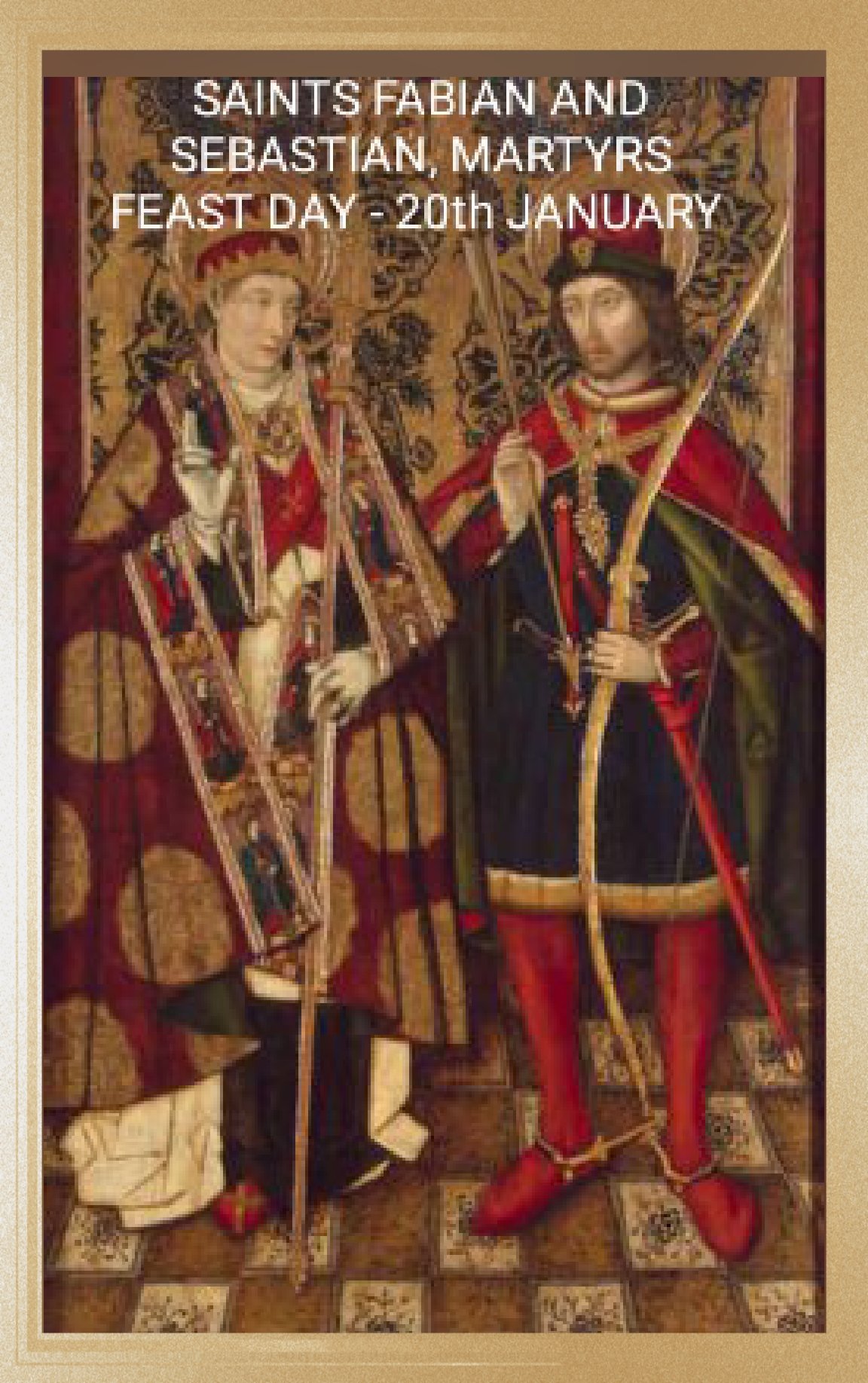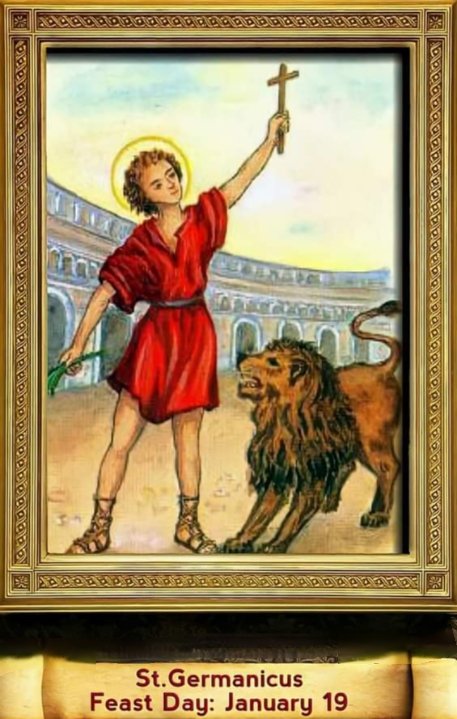FEAST OF SAINT CHRISTINA THE ASTONISHING AND SAINT CHRISTINA OF BOLSENA, VIRGIN AND MARTYR – 24th JULY
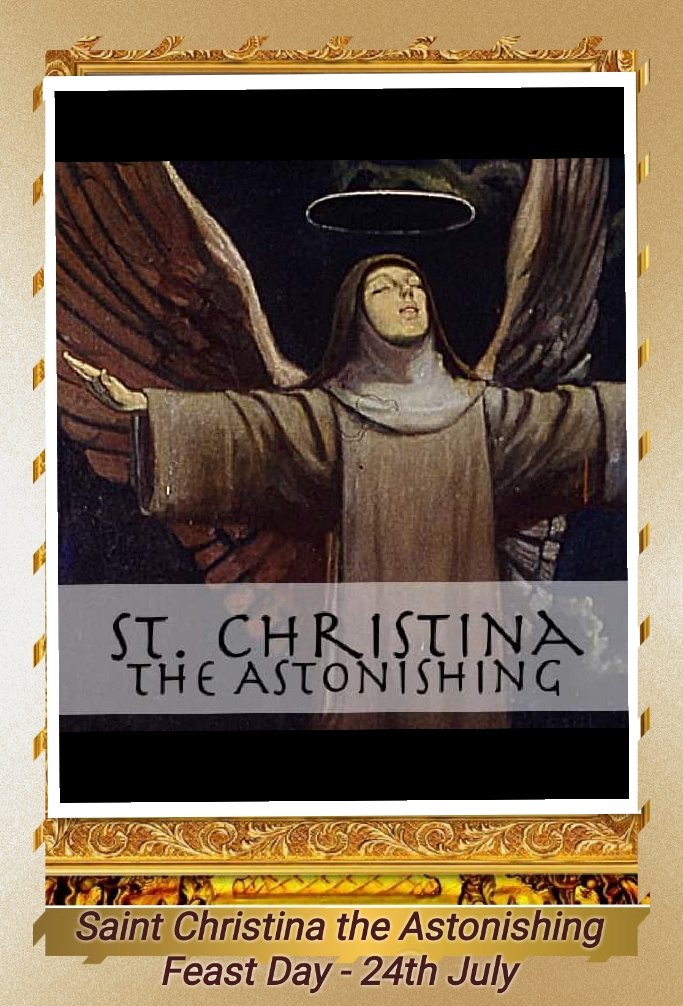
FEAST OF SAINT CHRISTINA THE ASTONISHING AND SAINT CHRISTINE OF BOLSENA, VIRGIN AND MARTYR
FEAST DAY – 24th JULY
Christina the Astonishing (c.1150 – 24 July 1224), also known as Christina Mirabilis, was a Christian holy woman born in Brustem (near Sint-Truiden), Belgium. She was considered a saint in her own time, and for centuries following her death, as noted by her appearance in the Fasti Mariani Calendar of Saints of 1630,[1] and Butler’s Lives of the Saints – Concise Edition, published in the 18th century.
Her notability began when she was 21 years old. About to be buried and already in the church resting in an open coffin, according to the custom of the time, during the Agnus Dei of her funeral Mass she arose, stupefying with amazement the whole city of St. Trond, which had witnessed this wonder. She subsequently lived a long life, dying at the age of seventy-four.
She is recognized as a Saint by the Catholic Church and commemorated in the current edition of the Martyrologium Romanum (Roman Martyrology) on 24 July, the day of her death. Some think that Christina receives attention today as much for the curious descriptions of her miracles as for her faith.
Christina was born to a religious family, the youngest of three daughters. After being orphaned at the age of fifteen, she worked taking the herds to pasture. She suffered a massive seizure when she was in her early 20s. Her condition was so severe that witnesses assumed she had died. A funeral was held, but during the service, “she arose full of vigour, stupefying with amazement the whole city of Sint-Truiden, which had witnessed this wonder. She levitated up to the rafters, later explaining that she could not bear the smell of the sinful people there.”
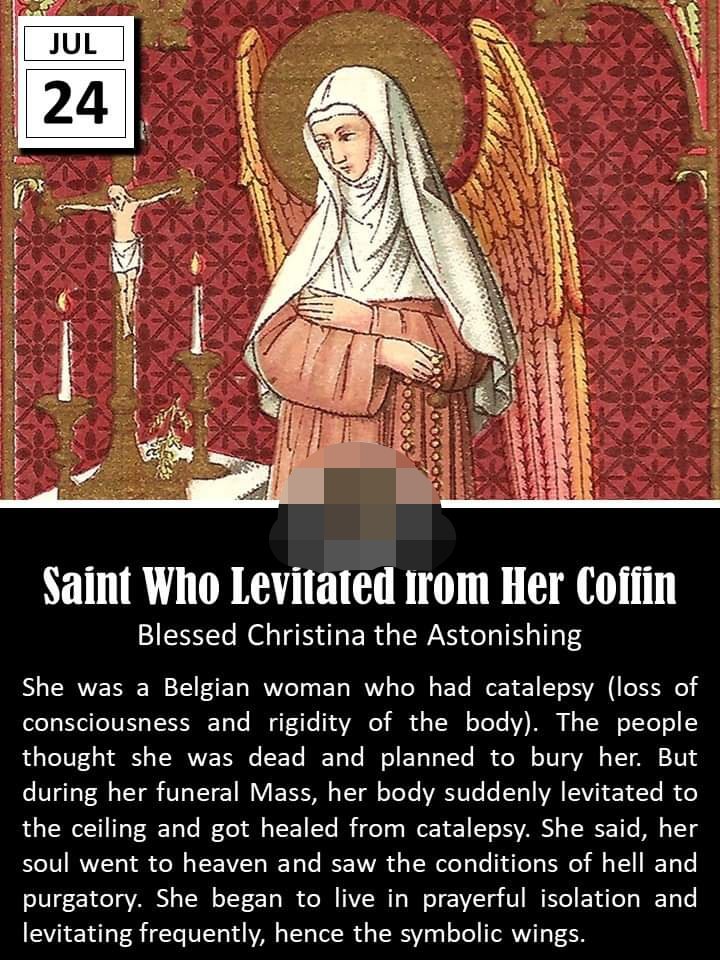
She related that she had witnessed Heaven, Hell and Purgatory. She said that as soon as her soul was separated from her body, angels conducted it to a very gloomy place, entirely filled with souls enduring torments there were such that it was impossible to describe them. She claimed that she had been offered a choice of either remaining in heaven or returning to earth to perform penance in order to deliver souls from the flames of Purgatory.
Christina agreed to return to life and in that instant stood up. She told those around her that she had returned to life for the sole purpose of bringing relief to the departed and conversion to sinners. Christina renounced all of life’s comforts, reduced herself to extreme destitution, dressed in rags, lived without home or hearth, and not content with these privations eagerly sought out all that could cause her suffering.
At first, she fled human contact and, suspected of being possessed, was jailed. Upon her release, she took up the practice of extreme penance. Thomas of Cantimpré then a canon regular who was a professor of theology, wrote a report eight years after her death, based on the accounts of those who knew her.
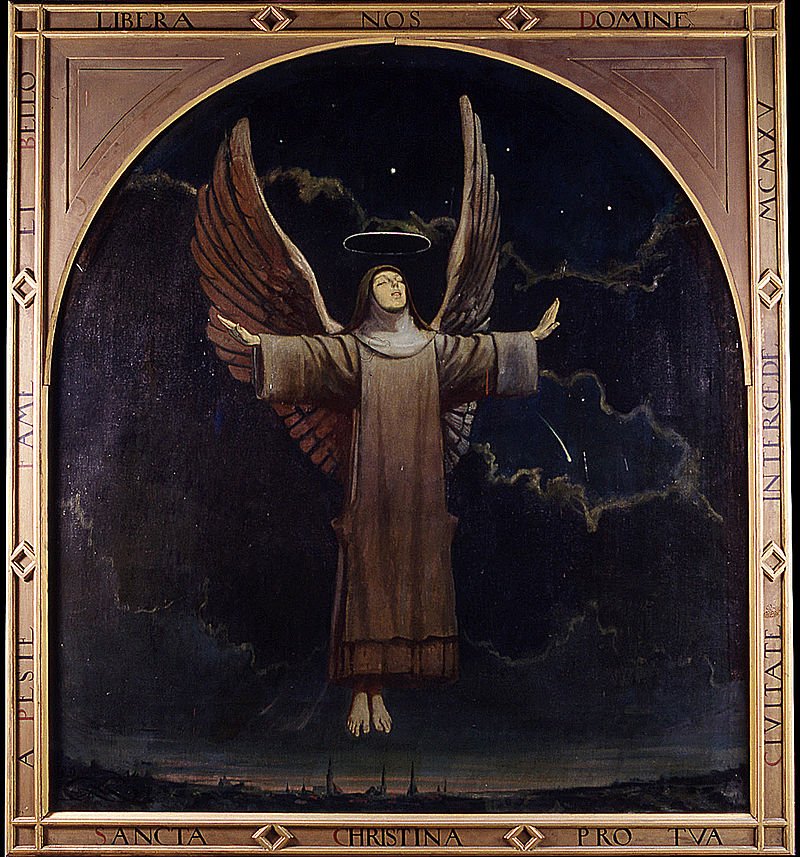
“We have”, wrote St Robert Bellarmine, “reason for believing his testimony, since he has for guarantee another grave author, Jacques de Vitry, Bishop and Cardinal, and because he relates what happened in his own time, and even in the province where he lived. Besides, the sufferings of this admirable virgin were not hidden. Everyone could see that she was in the midst of the flames without being consumed, and covered with wounds, every trace of which disappeared a few moments afterwards.
But more than this was the marvellous life she led for forty-two years after she was raised from the dead, God clearly showing that the wonders wrought in her by virtue from on high. The striking conversions which she effected, and the evident miracles which occurred after her death, manifestly proved the finger of God, and the truth of that which, after her resurrection, she had revealed concerning the other life.”
Thus, argues Bellarmine, “God willed to silence those libertines who make open profession of believing in nothing, and who have the audacity to ask in scorn, Who has returned from the other world? Who has ever seen the torments of Hell or Purgatory? Behold two witnesses. They assure us that they have seen them and that they are dreadful. What follows, then, if not that the incredulous is inexcusable, and that those who believe and nevertheless neglect to do penance are still more to be condemned?”
The reference was to Cardinal Jacques de Vitry, who met her and recounted that she would throw herself into burning furnaces and there suffer great tortures for extended times, uttering frightful cries, yet coming forth with no sign of burns upon her. In winter she would plunge into the frozen Meuse River for hours and even days and weeks at a time, all the while praying to God and imploring his mercy.
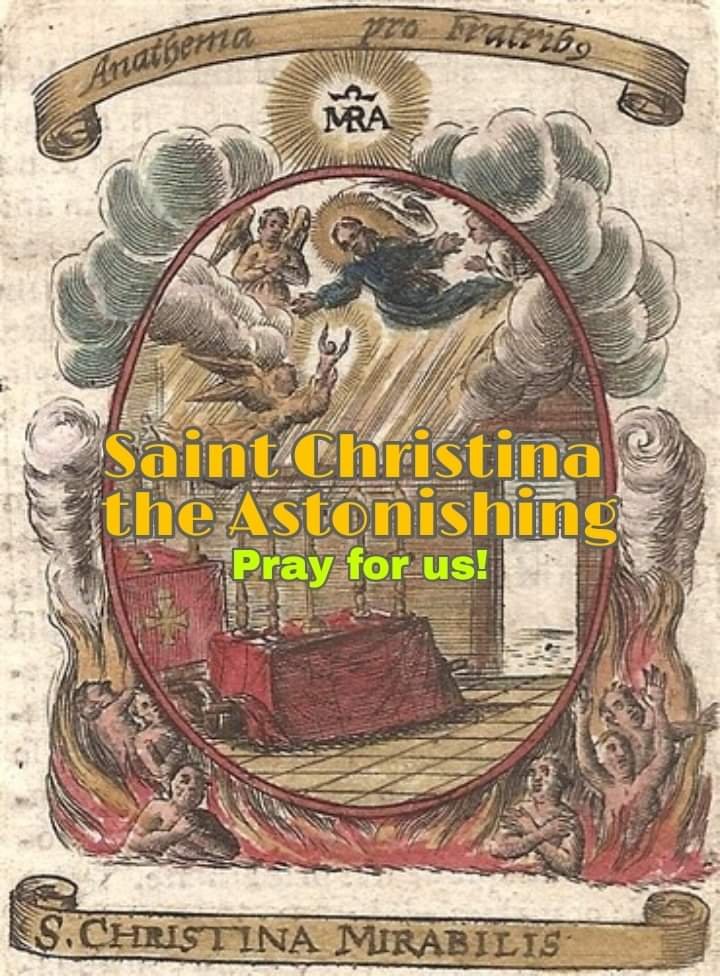
She sometimes allowed herself to be carried by the currents downriver to a mill where the wheel “whirled her round in a manner frightful to behold”, yet she never suffered any dislocations or broken bones. She was chased by dogs which bit her. After being jailed a second time, upon her release she moderated her approach somewhat.
Christina died at the Dominican Convent of Saint Catherine in Sint-Truiden, of natural causes, aged 74. The prioress there later testified that, despite her behaviour, Christina would humbly and fully obey any command given her by the prioress. St Christina the Astonishing has been recognized as a saint since the 12th century. She was placed in the calendar of the saints by at least two bishops of the Catholic Church in two different centuries (17th & 19th) that also recognized her life in a religious order and preservation of her relics.
The Catholic Church allows and recognizes veneration of saints upheld by the laity; canonization is understood as a re-affirming of the more notable examples of Christian life as mentioned in the Catechism of the Catholic Church, and Saint Christina the Astonishing, having early Church recognition, is due her title of Saint as stated by the Church’s Magisterium and Sacred Tradition.
Veneration of Christina the Astonishing has never been formally approved by the Catholic Church, but there remains a strong devotion to her in her native region of Limburg. Prayers are traditionally said to Christina to seek her intercession for millers, for those suffering from mental illness, and for mental health workers.
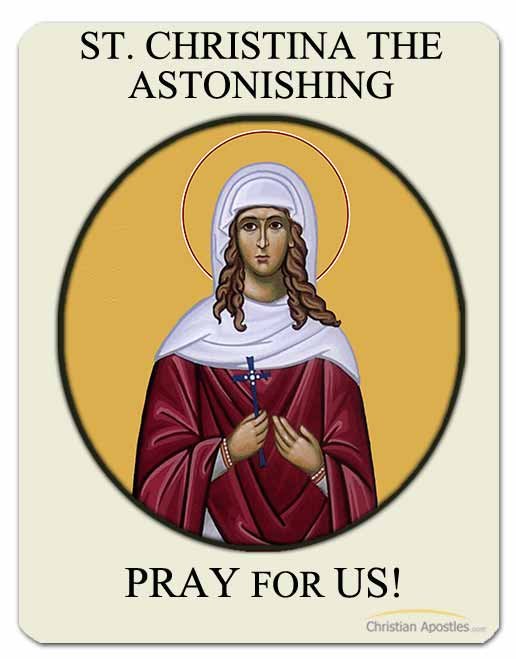
PRAYER
Saint Christina, your indefatigable courage and your piety and excruciating penance for the suffering souls in Purgatory, set you apart and forced recognition of your sainthood by those witnessing it.
Pray for me that I, too, may one day glorify the Blessed Trinity in heaven. May I possess your lively faith, that I may consider all persons, things, and events in the light of Almighty God. Help me to generously make sacrifices of temporal things to gain an eternal heritage in heaven.
Through your intercession and exceeding devotion to Mother Mary, keep me from mortal sin and obtain for me the grace of a happy death. Amen
=================================
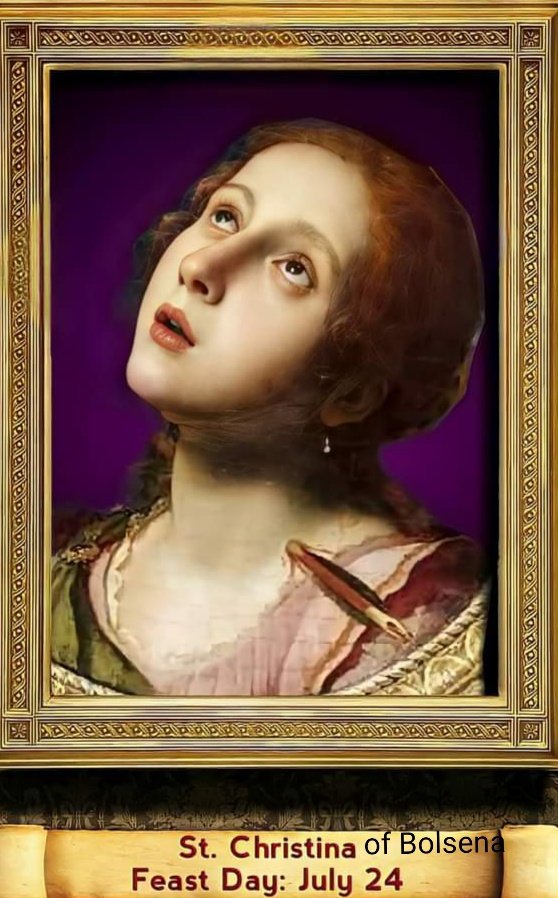
Christina of Bolsena, also known as Christina of Tyre, or in the Eastern Orthodox Church as Christina the Great Martyr, is venerated as a Christian martyr of the third century. Archaeological excavations of an underground cemetery constructed over her tomb have shown that she was venerated at Bolsena by the fourth century.
The existence of Christina herself is poorly attested. Some versions of her legend place her in Tyre (Phoenicia), while other evidence points to Bolsena, an ancient town in central Italy near an Etruscan settlement called Volsinium. There were found some catacombs in which were the remains of an early Christian church and the tomb of a female martyr.
Inscriptions at the site confirmed the martyr had a name like “Christina”, and that the local community was already venerating her as a saint by the end of the fourth century. Some corroborating evidence is also provided by a sixth-century mosaic in the Basilica of Sant’Apollinare Nuovo in Ravenna, which includes a procession of virgins, one of which is a saint named Christina wearing a martyr’s crown.
Christina is an early virgin Christian martyr. By the ninth century, an account of her martyrdom was composed, which developed many variants. According to these, she was born either in Tyre (Eastern stories) or in Persia (Western stories) during the third century or fifth century. She was born into a rich family, and her father was governor of Tyre.
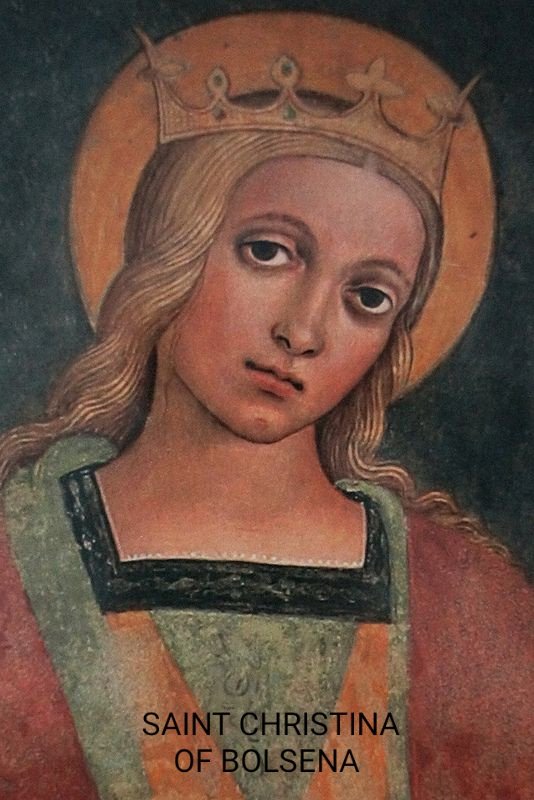
By the age of 11, the girl was exceptionally beautiful, and many wanted to marry her. Christina’s father, however, envisioned that his daughter should become a pagan priestess. To this end, he placed her in a special dwelling where he had set up many gold and silver idols, and he commanded his daughter to burn incense before them. Two servants also attended Christina.
According to some accounts, Christina was once visited by an angel, who instructed her in the Christian religion. The angel then called her a bride of Christ and told her about her future suffering. Christina then smashed all the idols in her room and threw the pieces out the window. On visiting his daughter, Christina’s father, Urbanus, asked her where all the idols had disappeared.
Christina was silent, but upon summoning the two servants, Urbanus learned the truth from them. Urbanus had his daughter tortured because of her faith, but God thwarted his efforts. The nature of her torture varies with each source, and can include iron hooks, grilling by fire, placement in a furnace, torture on the wheel, assault by snakes, assailment by arrows, and other assorted methods, all of which she survived.
After her father’s death, his successor Dion continued to torture her. Christina was eventually beheaded. The entry for her in the 2004 Roman Martyrology is very brief: “At Bolsena in Tuscany, Saint Christina, Virgin and Martyr”. She was once included in the General Roman Calendar; the older Tridentine Calendar gave her a commemoration within the Mass of the Vigil of Saint James the Great.
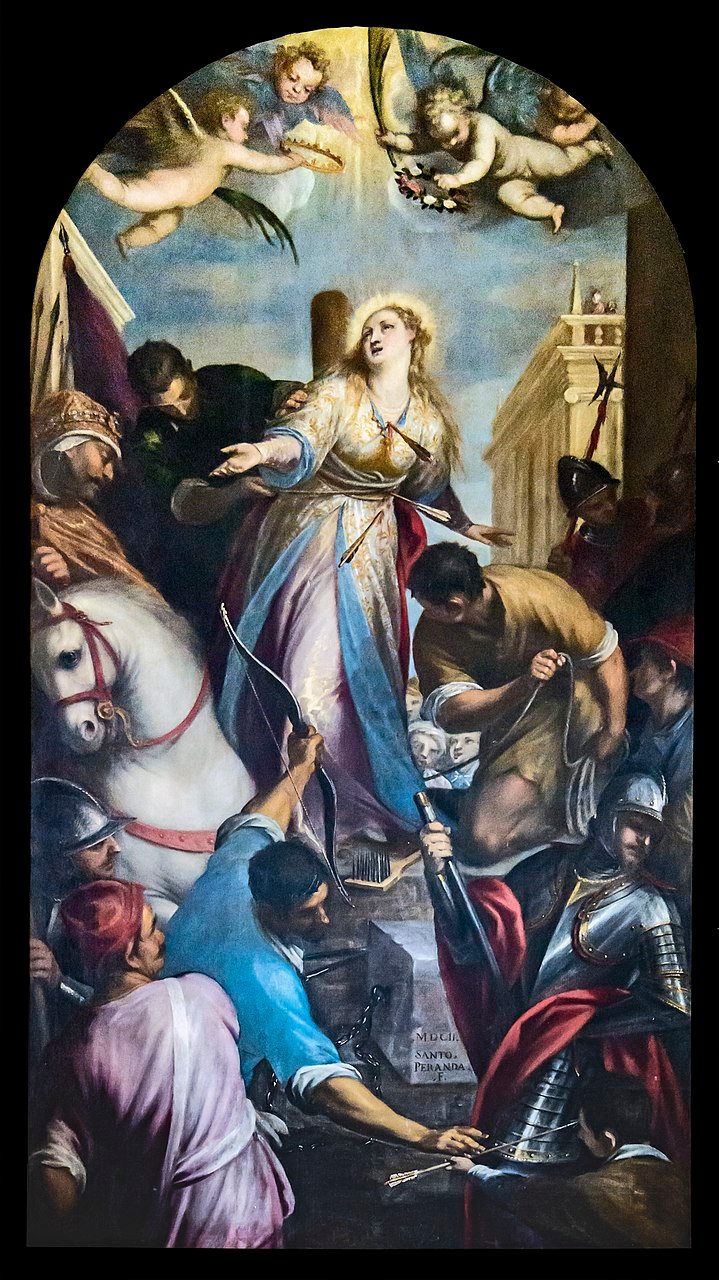
Chapel of our Lady of the Rosary of Santi Giovanni e Paolo (Venice) – Martyrdom of St Christina by Sante Peranda
When Pope Pius XII suppressed this vigil as part of his 1955 reforms, celebration of Saint Christina became “simple” and by 1960, a “commemoration”. The 1969 revision omitted her from that calendar, “because nothing is known of this virgin and martyr apart from her name and her burial at Bolsena”, but not from the Martyrology, the official list of recognized saints.
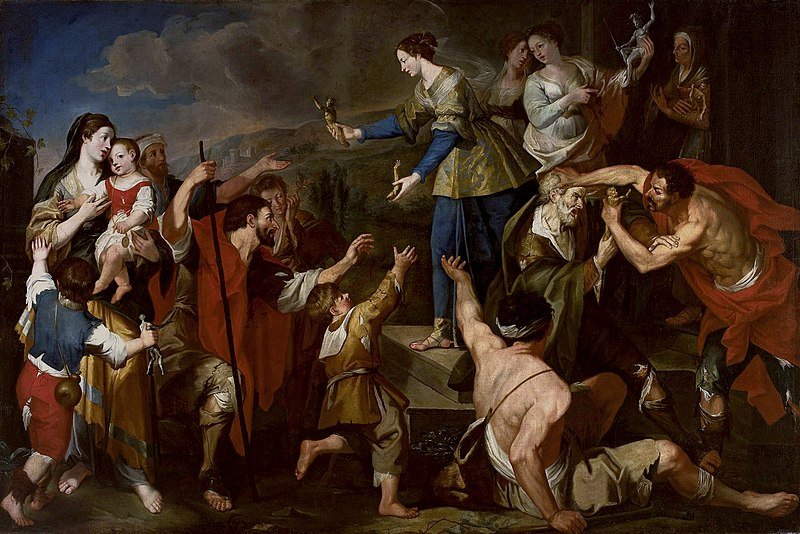
According to the present rubrics of the Roman Missal, Saint Christina may be celebrated with a “memorial” everywhere on her feast day, unless in some locality a different, obligatory celebration is assigned to that day. Toffia in the Province of Rieti displays her relics in a transparent urn. Palermo, of which Christina is one of four patron saints, also claims to enshrine her relics at the Church of Santa Cristina Gela, an Arbëresh village 20 kilometres south of the city.
Eastern tradition connects Christina with Tyre, Lebanon, but this may be due to confusion with the name of a different locality near Bolsena. Contrary to local belief, Saint Christina of Bolsena is not the individual whose relics are enshrined in the Cathedral of Saint John the Evangelist in Cleveland, Ohio.
A second legend is connected to Christina. The Eucharistic miracle, depicted in Raphael’s The Mass at Bolsena, is often considered to be the catalyst for the Feast of Corpus Christi. In the Umbria region in 1263, a priest named Peter from Prague harboured doubts on the Real Presence of Christ in the Host during Mass via transubstantiation.
During his pilgrimage towards Rome he prayed to be relieved of his questions. Peter said Mass at the Basilica of Santa Cristina in Bolsena: as he repeated the Words of Institution, the Host dripped the Precious Blood on his hands, and spilled it onto the corporal beneath.
PRAYER
O Venerable Christina, who calmly went through all sorts of torture, you made yourself visible as a shining dove, with a pair of golden wings alighting in the Highest Heavens.
O Virgin and Martyr, we celebrate your righteousness and holiness at your feast and bow before the place that holds your relics. Intercede for us, that we may receive grace and healing for body and soul. Amen
